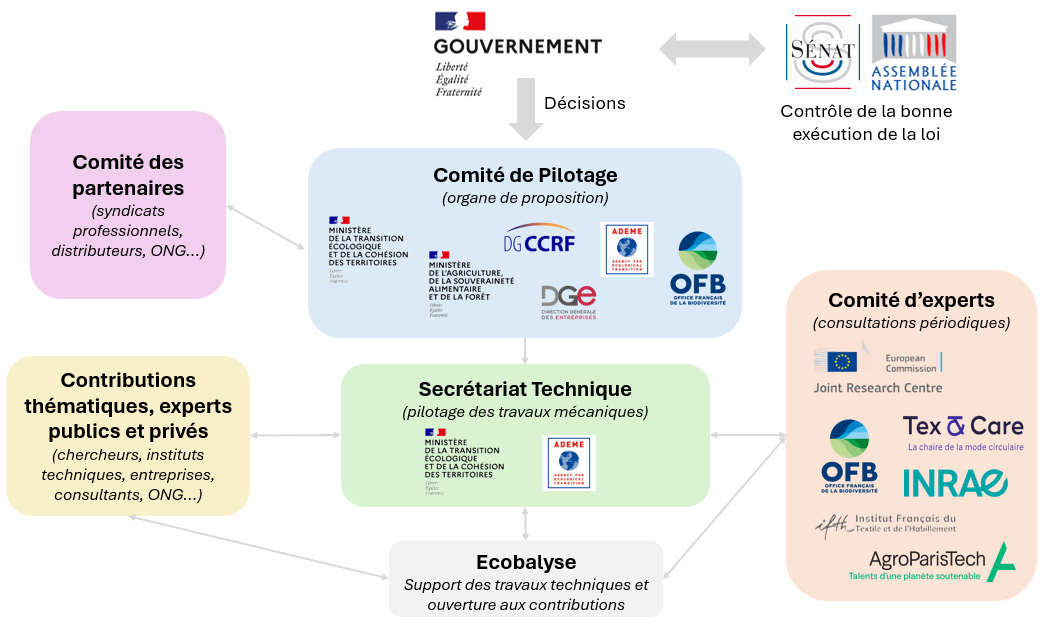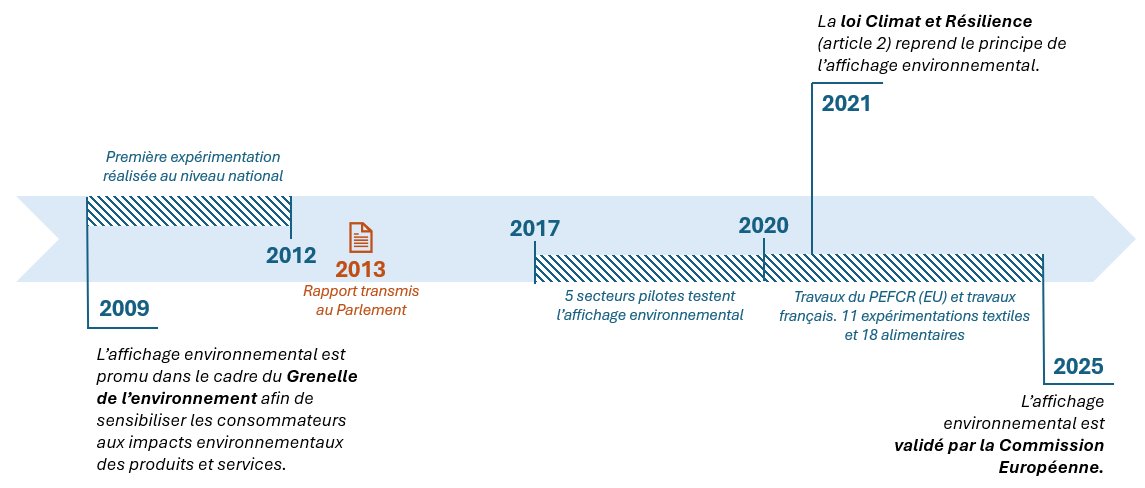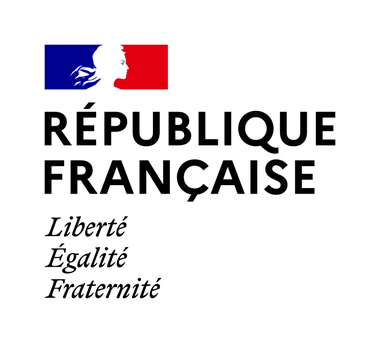Ecolabelling
Environmental labelling (EL) aims to inform consumers about the environmental impact of the products and services they consume. Using a ‘numerical value’, it makes it possible to reflect the impact of the various products placed on the market, and thus to:
-
help consumers to choose products and services with less impact,
-
encourage producers to produce in a more environmentally-friendly way.
Product labelling applies to all products in a given market sector, and complements the labels that distinguish ‘better’ products that meet specific specifications. Like price, which reflects the ‘financial cost’ of products, environmental labelling aims to reflect the ‘environmental cost/cost to the planet’ of goods and services sold. The higher the value, the higher the environmental cost.
The format and visuals are currently being defined by the public authorities.
Actualités et priorités
Mise à jour : mai 2025
La priorité de l'ADEME et des pouvoirs publics est d'accompagner le déploiement de l'affichage environnemental en 2025 sur plusieurs secteurs. Pour le textile, le décret a été publié en septembre et le dispositif est en cours de déploiement volontaire. Sur l'alimentaire, une consultation technique est en cours jusqu'au 30 octobre 2025. Des travaux techniques exploratoires ont débuté sur le secteur de l'ameublement et des "véhicules intermédiaires" (Véli). Sur la base du retour d'expérience, le dispositif s'élargira dans les années à venir afin de couvrir les principaux produits de consommation et services. Il n'y a pas de travaux en cours par les pouvoirs publiques sur les autres secteurs actuellement.
Cadre technique
Le dispositif d’affichage environnemental repose sur un ensemble d’outils conçus pour calculer un « score d’impact » et garantir la comparabilité des résultats entre produits. Il se compose des éléments suivants :
- Les principes généraux et le cadre méthodologique : communs à toutes les catégories de produits, ils s’appuient sur des référentiels tels que la Product Environmental Footprint (PEF, cadre européen) ou le BPC 30-323 (cadre français). Ces référentiels sont fondés sur l’analyse du cycle de vie (ACV).
- Des référentiels sectoriels : ils déclinent le cadre méthodologique commun en précisant les modalités de calcul propres à chaque catégorie de produits. Ils peuvent également intégrer des indicateurs complémentaires aux standards ACV, comme l’indicateur microplastique pour le textile.
- Une base de données ACV générique : elle fournit des valeurs environnementales par défaut nécessaires aux calculs (ex. : impact de l’électricité, des matériaux, des transports, etc.). L’ADEME développe, en partenariat, les bases Empreinte et Agribalyse, mobilisées dans le cadre de l’affichage.
- Des outils de calcul publics ou privés : ils facilitent la mise en œuvre du dispositif. Exemple : la plateforme Ecobalyse.
- Le format d’affichage : il comprend une charte graphique et un logo, assurant une présentation cohérente et reconnaissable pour les consommateurs.
Gouvernance du projet
Le dispositif d’affichage environnemental est piloté au niveau politique par le Ministère de la Transition Ecologique et de la Cohésion des Territoires (MTECT), avec l’appui de l’ADEME en tant qu’opérateur technique.

Le projet est organisé selon une gouvernance usuelle : comité de pilotage interministériel, secrétariat technique, conseil scientifique et comité des partenaires.

Historique des travaux et retours d'expérience
L’affichage environnemental est une démarche initiée dès 2009 dans le cadre du Grenelle de l’environnement, dont l'objectif est de sensibiliser les consommateurs aux impacts environnementaux des produits et services. Cette initiative a été reprise par la Convention citoyenne pour le climat, puis intégrée dans plusieurs textes législatifs, dont le plus récent est la loi "Climat et Résilience" de 2021 (article 2).

Durant cette période, 168 entreprises, distributeurs et fédérations professionnelles ont participé à une première expérimentation de l’affichage environnemental sur des produits de consommation courante. Des indicateurs d’impact environnemental ont été apposés sur certains produits afin de tester la faisabilité du dispositif.
Cette expérimentation, menée à l’échelle nationale, a donné lieu à un rapport transmis au Parlement en 2013. Les principaux enseignements sont les suivants :
- Une initiative pionnière, positionnant la France comme leader sur le sujet
- La pertinence d’une approche multicritère, fondée sur l’analyse du cycle de vie (ACV), pour évaluer les impacts environnementaux
- Un levier potentiel de compétitivité économique et de performance environnementale pour les entreprises
- Une attente forte des consommateurs, en quête d’informations fiables et transparente
- La nécessité de développer des données et des méthodologies communes, afin de mieux couvrir l’ensemble des enjeux environnementaux (ex. : carbone du sol, biodiversité), avant de valider un cadre officiel.
À la suite de cette première phase, les travaux techniques ont été poursuivis par l’ADEME, à travers diverses expérimentations sectorielles et en lien avec les initiatives européennes.
Entre 2017 et 2020, cinq secteurs pilotes ont testé à nouveau l’affichage environnemental sur leurs produits ou services : l’électronique, l’alimentation, l’habillement, l’ameublement et l’hôtellerie.
Ces projets avaient plusieurs objectifs :
- Réaliser le calcul de l’affichage environnemental en utilisant les référentiels, la Base de données IMPACTS ® (dorénavant base Empreinte) et les outils disponibles, et collecter du retour d’expérience
- Utiliser l’affichage environnemental comme un levier pour initier des démarches d’écoconception
- Communiquer les résultats de l’affichage environnemental auprès des consommateurs et inciter les entreprises de ces secteurs à se lancer
- Fournir des bilans et retours d'expériences.
Depuis 2021, les pouvoirs publics ont concentré leurs efforts sur les secteurs alimentaire et textile, considérés comme prioritaires pour le déploiement du dispositif.
En 2013, la Commission européenne a publié une recommandation invitant les États membres et les acteurs économiques à adopter des méthodes harmonisées pour évaluer les impacts environnementaux :
- PEF (Product Environmental Footprint) : pour les produits
- OEF (Organisation Environmental Footprint) : pour les organisations.
Ces cadres méthodologiques visent à garantir la comparabilité, la transparence et la robustesse des évaluations environnementales à l’échelle européenne.


